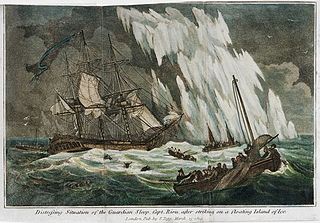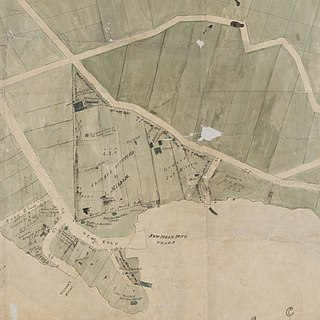
The First Fleet was the 11 ships that departed from Portsmouth, England, on 13 May 1787 to found the penal colony that became the first European settlement in Australia. The Fleet consisted of two Royal Navy vessels, three store ships and six convict transports, carrying between 1,000 and 1,500 convicts, marines, seamen, civil officers and free people, and a large quantity of stores. From England, the Fleet sailed southwest to Rio de Janeiro, then east to Cape Town and via the Great Southern Ocean to Botany Bay, arriving over the period of 18 to 20 January 1788, taking 250 to 252 days from departure to final arrival.

John White was an Irish surgeon and botanical collector.
William Balmain was a Scottish-born naval surgeon and civil administrator who sailed as an assistant surgeon with the First Fleet to establish the first European settlement in Australia, and later to take up the appointment of the principal surgeon, for New South Wales.

Scarborough was a double-decked, three-masted, ship-rigged, copper-sheathed, barque that participated in the First Fleet, assigned to transport convicts for the European colonisation of Australia in 1788. Also, the British East India company (EIC) chartered Scarborough to take a cargo of tea back to Britain after her two voyages transporting convicts. She spent much of her career as a West Indiaman, trading between London and the West Indies, but did perform a third voyage in 1801-02 to Bengal for the EIC. In January 1805 she repelled a French privateer of superior force in a single-ship action, before foundering in April.
The Second Fleet was a convoy of six ships carrying settlers, convicts and supplies to Sydney Cove, Australia in 1789. It followed the First Fleet which established European settlement in Australia in the previous year.

Surprize was a three-deck merchant vessel launched in 1780 that made five voyages as a packet ship under charter to the British East India Company (EIC). The fourth of which was subsequent to her participating in the notorious Second Fleet transporting convicts to Port Jackson (EIC). Her fifth voyage for the EIC was subsequent to her second voyage transporting convicts to Australia. In 1799 a French frigate captured her in the Bay of Bengal.

HMS Guardian was a 44-gun Roebuck-class fifth-rate two-decker of the Royal Navy, later converted to carry stores. She was completed too late to take part in the American War of Independence, and instead spent several years laid up in ordinary, before finally entering service as a store and convict transport to Australia, under Lieutenant Edward Riou. Riou sailed the Guardian, loaded with provisions, animals, convicts and their overseers, to the Cape of Good Hope where he took on more supplies. Nearly two weeks after his departure on the second leg of the journey, an iceberg was sighted and Riou sent boats to collect ice to replenish his water supplies. Before he could complete the re-provisioning, a sudden change in the weather obscured the iceberg, and the Guardian collided with it while trying to pull away. She was badly damaged and in immediate danger of sinking. The crew made frantic repair attempts but to no apparent avail. Riou eventually allowed most of the crew to take to the Guardian's boats, but refused to leave his ship. Eventually through continuous work he and the remaining crew were able to navigate the ship, by now reduced to little more than a raft, back to the Cape, a nine-week voyage described as 'almost unparalleled'. Riou ran the Guardian aground to prevent her sinking, but shortly afterwards a hurricane struck the coast, wrecking her. The remains were sold the next year, in 1790.

Edward Riou FRS was an officer of the Royal Navy who served during the French Revolutionary Wars under several of the most distinguished naval officers of his age and won fame and honour for two incidents in particular.
The Third Fleet comprised 11 ships that set sail from the United Kingdom in February, March and April 1791, bound for the Sydney penal settlement, with more than 2,000 convicts aboard. The passengers comprised convicts, military personnel and notable people sent to fill high positions in the colony. More important for the fledgling colony was that the ships also carried provisions.

Hougoumont was the last convict ship to transport convicts to Australia.
William Hammond was a barque used to transport convicts to Western Australia.
Scindian is widely considered the first convict ship to transport convicts to Western Australia.

Surry, also known as Surrey, had an especially long career transporting convicts to Australia. In 11 voyages, the most of any convict transport, she brought 2,177 convicts, male and female, and so became one of the best-known of the vessels that visited Australia. In all, she lost 51 men and one woman during her various passages, 46 of the men dying during her first and most notorious voyage in 1814 when she was under the command of James Patterson.
Guildford was a two-decker merchant ship launched in 1810. She transported convicts to New South Wales. Of her eight voyages delivering convicts, for three she was under charter to the British East India Company (EIC). She underwent major repairs in 1819, her hull was sheathed in copper in 1822; in 1825 she received new wales, top sides and deck, the copper was repaired and other repairs. Guildford was lost without a trace in 1831.

There are 20 known contemporary accounts of the First Fleet made by people sailing in the Fleet, including journals and letters. The eleven ships of the Fleet, carrying over 1,000 convicts, soldiers and seamen, left England on 13 May 1787 and arrived in Botany Bay between 18 and 20 January 1788 before relocating to Port Jackson to establish the first European settlement in Australia, a penal colony which became Sydney. At least 12 people on the Fleet kept a journal of their experiences, some of which were later published, while others wrote letters home during the voyage or soon after their arrival in Australia. These personal accounts of the voyage were made by people including surgeons, officers, soldiers, ordinary seamen, and Captain Arthur Phillip, who commanded the expedition. Only one known account, that of James Martin, was by a transported convict. Their journals document the day to day experiences of those in the Fleet, and record significant events including the first contact between the European settlers and the Aboriginal people of the area. In 2009, the manuscript journals were included in The Australian Memory of the World Register, a regional register associated with the UNESCO international Memory of the World programme.

Arthur Bowes Smyth was a naval officer and surgeon on the First Fleet that established the colony of New South Wales. Smyth kept a diary and documented the natural history he encountered in Australia.
Earl Grey was a merchant ship built at Newcastle upon Tyne, England in 1835. She made four voyages transporting convicts from Great Britain to Australia.

Waterloo was a merchant ship built at Bristol, England in 1815. On her first voyage she suffered a short-lived mutiny. She then made one voyage under charter to the British East India Company (EIC). She made four voyages transporting convicts from England to Australia, and two voyages from Ireland to Australia. On her seventh convict voyage Waterloo wrecked on 28 August 1842 in Table Bay with great loss of life.
Royal Sovereign was a 336-ton merchant ship built at Whitby, England in 1829. She made one voyage transporting convicts from England to Australia and one voyage from Ireland to Australia.
Chapman was a two-deck merchant ship built at Whitby in 1777. She made three voyages to India or China for the British East India Company (EIC), during the first of which she was present at the battle of Porto Praya. During the French Revolutionary Wars she served as a hired armed ship, primarily escorting convoys but also seeing some action. Later, she undertook one voyage to Mauritius transporting troops, and three voyages transporting convicts from England and Ireland to Australia. She was last listed in 1853.












